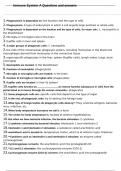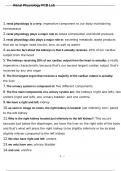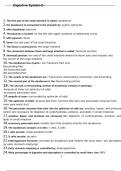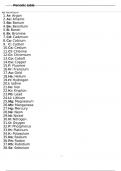Smartchoices
On this page, you find all documents, package deals, and flashcards offered by seller smartchoices.
- 1598
- 0
- 123
Community
- Followers
- Following
1 Reviews received
1726 items

Autonomy exam elaboration bundle ( Test Bank)
Autonomy exam elaboration bundle ( Test Bank)
- Package deal
- • 7 items •
- Immune System-A Questions and answers • Exam (elaborations)
- Neuroendocrine Control Part 2 questions and Answers • Exam (elaborations)
- Immune System-B Questions and Answers • Summary
- Digestive system-A Questions plus Answers • Exam (elaborations)
- Digestive system-B • Exam (elaborations)
- And more ….
Autonomy exam elaboration bundle ( Test Bank)

Renal Physiology PCB Lab Questions and Answers
Renal Physiology PCB Lab 1. Why is the right kidney located just inferiorly to the left kidney?: This occurs because just below the diaphragm, we have the liver on the right side of the body and that's what will press the right kidney to be slightly inferiorly or be located slightly inferior compared to the left kidney 2. We also have right and left: ureters 3. we only have one: urinary bladder 4. and one: urethra
- Exam (elaborations)
- • 42 pages •
Renal Physiology PCB Lab 1. Why is the right kidney located just inferiorly to the left kidney?: This occurs because just below the diaphragm, we have the liver on the right side of the body and that's what will press the right kidney to be slightly inferiorly or be located slightly inferior compared to the left kidney 2. We also have right and left: ureters 3. we only have one: urinary bladder 4. and one: urethra

Digestive system-C Questions and Answers
Digestive system-C vity 12. The main function of salivary glands: secretion of saliva 13. The innervation of salivary glands: Facial Nerve (CN VII) & Glossopharyngeal Nerve (CN IX) 14. Sometimes we have viral infection of parotid gland, which is called: mumps 15. Mumps is: viral infection of the parotid gland 16. 70-80% of people who had mumps in childhood , may have risk for: infertil- ity; because this virus somehow effects the sex hormones during childhood and is a risk for infertility ...
- Package deal
- Exam (elaborations)
- • 6 pages •
Digestive system-C vity 12. The main function of salivary glands: secretion of saliva 13. The innervation of salivary glands: Facial Nerve (CN VII) & Glossopharyngeal Nerve (CN IX) 14. Sometimes we have viral infection of parotid gland, which is called: mumps 15. Mumps is: viral infection of the parotid gland 16. 70-80% of people who had mumps in childhood , may have risk for: infertil- ity; because this virus somehow effects the sex hormones during childhood and is a risk for infertility ...

Digestive System-D
Digestive System-D 14. ampulla of vatar: surrounded by sphincter of oddi 15. The sphincter of Oddi: receives bile from common bile duct and pancreatic enzymes from main pancreatic duct 16. The pancreatic enzymes that enter into the sphincter of oddi are: amylase, lipase, and protease (which are necessary for digestion of carbohydrates, proteins, and lipids in small intestine) 17. amylase, lipase, and protease are necessary for: digestion of carbohydrates, proteins, and lipids in small intest...
- Package deal
- Exam (elaborations)
- • 13 pages •
Digestive System-D 14. ampulla of vatar: surrounded by sphincter of oddi 15. The sphincter of Oddi: receives bile from common bile duct and pancreatic enzymes from main pancreatic duct 16. The pancreatic enzymes that enter into the sphincter of oddi are: amylase, lipase, and protease (which are necessary for digestion of carbohydrates, proteins, and lipids in small intestine) 17. amylase, lipase, and protease are necessary for: digestion of carbohydrates, proteins, and lipids in small intest...

Digestive system-B
Digestive system-B n GI tract, and specifically the stomach, we have many different types of cells. And each cell: secretes a specific hormone or enzyme, and each has a specific function 5. propulsive: peristalsis, "forward flow" 6. In propulsive (peristalsis, "forward flow"): the gastric content is actually under control of a spike wave 7. **Before receiving the food content by GI tract, we have: slow wave 8. **When it receives the food content, it then becomes: spike wave 9. ...
- Package deal
- Exam (elaborations)
- • 12 pages •
Digestive system-B n GI tract, and specifically the stomach, we have many different types of cells. And each cell: secretes a specific hormone or enzyme, and each has a specific function 5. propulsive: peristalsis, "forward flow" 6. In propulsive (peristalsis, "forward flow"): the gastric content is actually under control of a spike wave 7. **Before receiving the food content by GI tract, we have: slow wave 8. **When it receives the food content, it then becomes: spike wave 9. ...

Digestive system-A Questions plus Answers
Digestive system-A Questions plus Answers 5. Then the esophagus enters into: abdominal cavity through the diaphragm muscle which is connected to the stomach 6. The stomach is located in the: left upper quadrant abdominal cavity 7. After stomach, GI tract continues with the: duodenum 8. Duodenum is the: 1st part of small intestine
- Package deal
- Exam (elaborations)
- • 8 pages •
Digestive system-A Questions plus Answers 5. Then the esophagus enters into: abdominal cavity through the diaphragm muscle which is connected to the stomach 6. The stomach is located in the: left upper quadrant abdominal cavity 7. After stomach, GI tract continues with the: duodenum 8. Duodenum is the: 1st part of small intestine

Immune System-B Questions and Answers
Immune System-B Questions and Answers 3. The neutrophils, or white blood cells, are what: come to destroy the antigen 4. That antigen could be: bacteria, virus, etc. 5. Antibody has: antigen binding site 6. As you see, the structure of an antibody contains: heavy chain, light chain, and together form the antigen binding sites
- Package deal
- Summary
- • 3 pages •
Immune System-B Questions and Answers 3. The neutrophils, or white blood cells, are what: come to destroy the antigen 4. That antigen could be: bacteria, virus, etc. 5. Antibody has: antigen binding site 6. As you see, the structure of an antibody contains: heavy chain, light chain, and together form the antigen binding sites

Neuroendocrine Control Part 2 questions and Answers
Neuroendocrine Control Part 2 4. Is inhibitory depolarizing or hyperpolarizing?: hyperpolarizing 5. Is excitatory depolarizing or hyperpolarizing?: depolarizing 6. How do dendrites find neurotransmitter?: Dendrites move chemotaxically to- wards NTs as they are not directly attached to the axons 7. What are the steps of a chemical synapse?: 1.
- Package deal
- Exam (elaborations)
- • 8 pages •
Neuroendocrine Control Part 2 4. Is inhibitory depolarizing or hyperpolarizing?: hyperpolarizing 5. Is excitatory depolarizing or hyperpolarizing?: depolarizing 6. How do dendrites find neurotransmitter?: Dendrites move chemotaxically to- wards NTs as they are not directly attached to the axons 7. What are the steps of a chemical synapse?: 1.

Immune System-A Questions and answers
Immune System-A Questions and answers 5. But how can we decrease the body temperature or fever?: We give aspirin or ibuprofen 6. aspirin and ibuprofen mechanism is that it: blocks the cyclooxygenase en- zyme effect 7. When aspirin and ibuprofen blocks the cyclooxygenase enzyme effect, then: arachidonic acid is not able to be converted as prostaglandin E2 Because Cyclooxygenase enzyme (COX-2) converts: the
- Package deal
- Exam (elaborations)
- • 4 pages •
Immune System-A Questions and answers 5. But how can we decrease the body temperature or fever?: We give aspirin or ibuprofen 6. aspirin and ibuprofen mechanism is that it: blocks the cyclooxygenase en- zyme effect 7. When aspirin and ibuprofen blocks the cyclooxygenase enzyme effect, then: arachidonic acid is not able to be converted as prostaglandin E2 Because Cyclooxygenase enzyme (COX-2) converts: the


Health Ecosystem D391 WGU | Exam Questions, Answers and Summaries